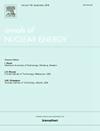排列和组合方式对屏蔽材料性能的影响
IF 1.9
3区 工程技术
Q1 NUCLEAR SCIENCE & TECHNOLOGY
引用次数: 0
摘要
复合材料已被广泛应用于提高屏蔽材料在中子和γ辐射场条件下的性能。研究人员一般利用蒙特卡罗软件根据辐射场的能谱信息设计构件,然后通过特定的工艺流程实现构件的均匀混合,最终获得具有预期性能的复合屏蔽材料。然而,由于复合材料各组分之间的性能差异很大,使它们均匀混合的过程既复杂又昂贵。在需要广泛使用和复杂的现场安装环境的特定情况下,这个缺点可能是不可接受的。以铅硼聚乙烯(PbBPE)为研究对象,采用Geant4软件结合k -近邻(KNN)算法,对具有相同质量分数和总质量但排列顺序不同的层合材料的性能进行了计算和分析。结果表明,在两层铅板之间填充硼聚乙烯(BPE)形成的三明治状复合材料的性能可能优于复合材料PbBPE。本文章由计算机程序翻译,如有差异,请以英文原文为准。
Effect of permutation and combination patterns on the performances of shielding materials
Composite materials have been extensively employed to enhance the performance of shielding materials under the condition of neutron and γ radiation fields. Researchers generally design the component based on the energy spectrum information of the radiation field with Monte Carlo software, then achieve the uniform mixing of components with specific technological processes, ultimately obtaining the composite shielding material with expected performance. However, due to the substantial differences in properties between the components of composite materials, the process of mixing them uniformly is complex and costly. This drawback may be unacceptable in specific situations such as scenarios requiring extensive use and complex on-site installation environments. Lead boron polyethylene (PbBPE), a widely studied and utilized composite material, was analyzed using the Geant4 software in conjunction with the K-Nearest Neighbors (KNN) algorithm to calculate and analyze the performance of laminated materials with the same mass fraction and total mass but with different permutations. The results indicate that the performance of the sandwich-like laminated material formed by filling boron polyethylene (BPE) between two layers of lead (Pb) plates may be superior to that of the composite material PbBPE.
求助全文
通过发布文献求助,成功后即可免费获取论文全文。
去求助
来源期刊

Annals of Nuclear Energy
工程技术-核科学技术
CiteScore
4.30
自引率
21.10%
发文量
632
审稿时长
7.3 months
期刊介绍:
Annals of Nuclear Energy provides an international medium for the communication of original research, ideas and developments in all areas of the field of nuclear energy science and technology. Its scope embraces nuclear fuel reserves, fuel cycles and cost, materials, processing, system and component technology (fission only), design and optimization, direct conversion of nuclear energy sources, environmental control, reactor physics, heat transfer and fluid dynamics, structural analysis, fuel management, future developments, nuclear fuel and safety, nuclear aerosol, neutron physics, computer technology (both software and hardware), risk assessment, radioactive waste disposal and reactor thermal hydraulics. Papers submitted to Annals need to demonstrate a clear link to nuclear power generation/nuclear engineering. Papers which deal with pure nuclear physics, pure health physics, imaging, or attenuation and shielding properties of concretes and various geological materials are not within the scope of the journal. Also, papers that deal with policy or economics are not within the scope of the journal.
 求助内容:
求助内容: 应助结果提醒方式:
应助结果提醒方式:


